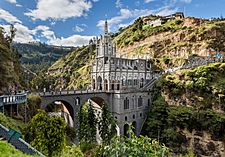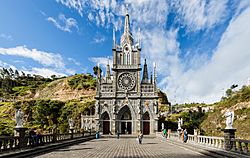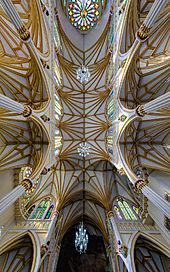Sanctuary of Las Lajas facts for kids
Quick facts for kids Basilica of Our Lady of the Holy Rosary of Las Lajas |
|
|---|---|
 |
|
| Religion | |
| Affiliation | Catholic Church |
| Location | |
| Location | Ipiales, Nariño, Colombia |
The Sanctuary of Las Lajas is a stunning Catholic church built right inside a deep canyon. It is located in Ipiales, Nariño Department, Colombia, next to the Guáitara River. This special place of worship is dedicated to the Blessed Virgin Mary, known here as Our Lady of the Rosary.
Many people believe a colorful image of the Virgin Mary and baby Jesus on the rock wall appeared there by itself, without any human help. The church you see today was built in a beautiful Gothic Revival style. Its construction took place between 1916 and 1949. The name Laja means "flat stone" in Spanish, referring to the flat sedimentary rock found in the area.
This sanctuary is a very popular place for pilgrimages. People travel from Colombia and nearby Ecuador to visit it. This is because a special event, called a Marian apparition, is said to have happened here in the 1700s.
Contents
History of the Sanctuary
How the Church Began
The idea for building this church came from a surprising event that supposedly happened around 1754. A woman named Maria Mueses de Quiñones and her daughter, Rosa, who could not hear or speak, were caught in a big storm. They found shelter among some flat stones, or Lajas. Suddenly, Rosa, who had never spoken before, exclaimed, "The Mestiza is calling me!" She pointed to a shape lit up by lightning on the rock.
This was believed to be an appearance of the Virgin Mary. After this, people started making pilgrimages to the spot. There were even reports of amazing healings. A special image appeared deep inside the stone wall, which you can still see today.
Building the Sanctuary
The first simple shrine at this location was made of straw and wood in the mid-1700s. A friar named Juan de Santa Gertrudis wrote about it during his travels between 1756 and 1764.
Later, around 1795, a brick chapel was built. Then, starting in 1802, a larger shrine was constructed. In the second half of the 1800s, this shrine was made even bigger. It was connected to the other side of the canyon by a bridge.
The current, grand church was built between January 1, 1916, and August 20, 1949. It was paid for by donations from people who attended the church. The church stands about 100 m (330 ft) (328 feet) tall from the bottom of the canyon. A 50 m (160 ft) (164 feet) tall bridge connects it to the opposite side.
Amazing Stories and Beliefs
The Shrine of Las Lajas is famous for its unique architecture. It is also known for several stories about the Virgin Mary appearing there. Plus, there's a mysterious painting on the wall whose origin is unknown. The church sits on a 50-meter (164-foot) high bridge over the Guaitara River. It is less than 11 kilometers (7 miles) from the border with Ecuador.
One popular story says that the Virgin Mary appeared to Maria Mueses de Quiñones and her daughter Rosa in 1754. This happened exactly where the church stands today. Maria and Rosa were seeking shelter from a storm by the Guaitara River. At that moment, Rosa, who was deaf and mute, suddenly shouted, "Mom, the Virgin is calling me!" She pointed to an image of the Virgin Mary.
Maria kept this amazing event a secret at first. But then something even more incredible happened. After Rosa passed away, Maria returned to the spot to pray for her daughter. The Virgin Mary then miraculously brought Rosa back to life! After this, Maria and Rosa could no longer keep the miracle a secret.
The first small shrine was built a few years after this event. This was recorded in the journal of a friar who traveled through the area between 1756 and 1764. About 50 years later, in 1802, a bigger shrine was built. Worshipers also built the first version of the bridge that now leads to the church.
The Mysterious Image
The appearance of the Virgin Mary is just one of the many mysteries connected to Las Lajas Sanctuary. For example, no one knows who created the image of the Virgin Mary that is behind the altar inside the church.
Some say the image was first seen when Maria Mueses wanted to show a priest and other local people where her daughter had been brought back to life. When they arrived, they saw the image of the Virgin Mary and Jesus printed right into the stone wall. It is believed that this image goes several feet deep into the stone. This amazing image attracts thousands of pilgrims every year.
Special Recognition
The revered image of the Virgin Mary at the shrine received a special honor called a canonical coronation on September 16, 1952. This was made possible by a decree from Pope Pius XII issued on May 31, 1951. The shrine itself was then given the important status of a minor basilica in 1954. In 1965, the image was also declared the Principal Patroness of the Diocese of Ipiales.
Las Lajas Sanctuary is considered one of the most popular pilgrimage sites in Colombia. Its location near the Ecuador border makes it a favorite destination for people from both countries.
See also
 In Spanish: Santuario de Las Lajas para niños
In Spanish: Santuario de Las Lajas para niños





